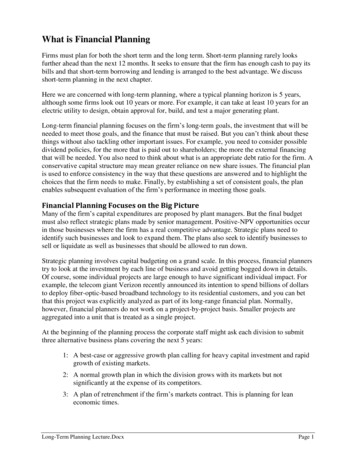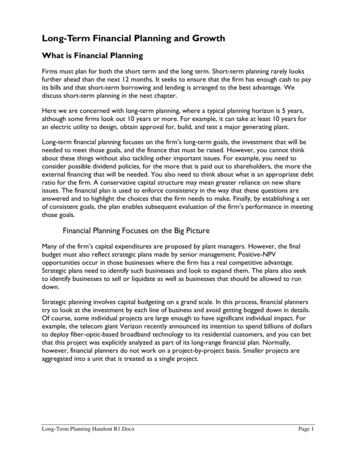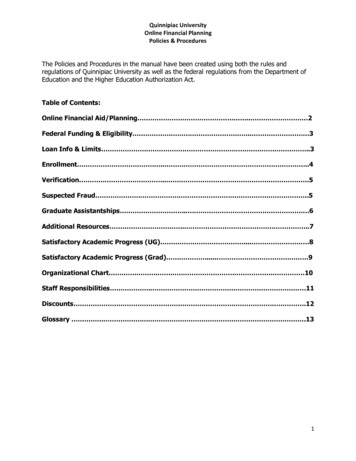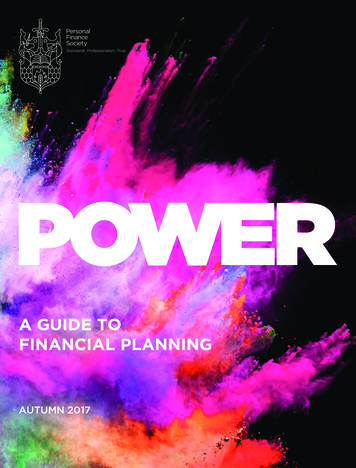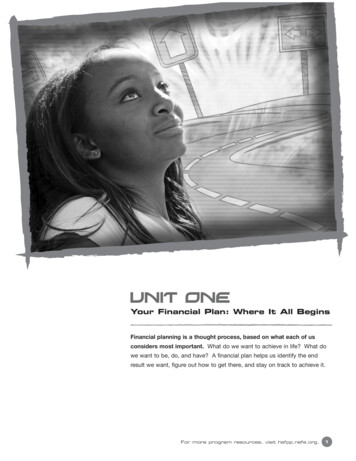
Transcription
Your Financial Plan: Where It All BeginsFinancial planning is a thought process, based on what each of usconsiders most important. What do we want to achieve in life? What dowe want to be, do, and have? A financial plan helps us identify the endresult we want, figure out how to get there, and stay on track to achieve it.For more program resources, visit hsfpp.nefe.org.1
Goal setting is the foundation of the financialplanning process. We begin with learning thedifference between needs and wants. Becauseresources are limited, we must learn to prioritize ourgoals—and needs usually come first. It’s OK tohave wants. Wants often motivate us to succeed.The key is being able to distinguish between a wantand a need and to use that understanding when wemake important choices and decisions.Decision making plays an important role in thefinancial planning process. We must make choicesin order to maximize our ability to accomplish ourgoals with limited resources. There’s a set processto making effective decisions, which we maynot even realize we’re using. Of course, somedecisions will create the need to make evenmore decisions.A value is a belief or idea we consider important ordesirable. Many factors come into play in shapingour values, which vary from person to person. Infact, our values will most likely change as we growand change. But values have a lot of influence onour goals and decision making.Goals are accomplished by applying the ongoing,five-step financial planning process represented bythe graphic in PowerPoint Visual 1-B (The Five-StepFinancial Planning Process).That process is:!It is essential for the students to understand severalthings about decision making. First, many decisionsinvolve trade-offs, sacrificing one option right nowin order to achieve another. Second, many personaland financial decisions made today will affectdecisions in the future. Finally, each decision carrieswith it related consequences that affect us, otherpeople, and the world around us. However, we canbecome skillful decision-makers through practice.In the end, you have to follow your financial plan inorder for it to work. So it’s important to considerways to motivate yourself to stick with it. It’s equallyimportant to know when it’s time to modify andupdate the plan. After all, a plan is not meant to beset in stone. Instead, it should be a living documentthat evolves with us over time.Materials you will need for this unit:NEFE High School Financial Planning ProgramStudent Guide: Unit 1 — Your Financial Plan:Where It All BeginsUnit 1 Teaching PlanUnit 1 OverviewPresentation Visuals: Unit 1 Visuals.xls;Unit 1 Visuals.ppt; Unit 1 Visuals.pdfEnvelopes for Assignment 1-3Assignment 1-1SMART Goals chart for Assignment 1-1Assignment 1-2Assignment 1-3Assignment 1-4Assignment 1-5Assignment 1-6Financial Planning Process cards for Assignment 1-6Assessment 1-1Assessment 1-2Access to InternetUnit 1 Newsletter Article2UNIT ONE: Instructor’s Manual
Teaching PlanUnit 1 Your Financial Plan: Where It All BeginsTotal Time — 160 MinutesTarget CompetencyCreate a personal financial plan.Learning ObjectivesabcdefExamine the value of having a process of planning how to use moneyCreate personal financial SMART goalsAnalyze how money is received and usedUse the decision-making process to create a financial planIdentify guidelines to implement a personal financial planMonitor and modify a personal financial planTeaching Plan ActivitiesStudent Learning/Assessment ActivitiesMinutesTeaching Activities2Hand out the Student Guide and introduce the NEFEHigh School Financial Planning Program (HSFPP) tothe students. Explain that by the time they complete theHSFPP, they will be able to develop their own, very basicfinancial plan.3055Preview Unit 1 with the students by reading page 1.Point out that they will use the information learned andpracticed in this unit to create their own personalfinancial plan using the guidelines stated on page 14.Optional: Copy and distribute the Unit 1 Overview(page 8) to preview what the students will learn and whatassignments will be submitted throughout the unit.Read page 1 to preview what you will learnabout and do in this unit.Assign students to read pp. 1–6 in advance to preparefor class presentation and exercises.Read the scenarios on page 2 to thinkabout reasons why teenagers spend orsave money.Arrange students in pairs to respond to the statements inthe What Do You Think? section. Discuss their answersbriefly as a class as you share the correct answers.What did they find most surprising or interesting inthe statements?Work with a partner to complete theWhat Do You Think? questionnaire.Check your answers after you completethe unit activities.Show PowerPoint Visual 1-A, Fail to Plan. Brieflydiscuss how a financial plan can be an important tool inhelping achieve goals.View a presentation about the financialplanning process and how wants andneeds impact the process.Show PowerPoint Visual 1-B, The Five-Step FinancialPlanning Process. Point out that the students willpractice the steps of the process and then apply theprocess to create their own financial plan.For more program resources, visit hsfpp.nefe.org.3
Minutes4Teaching ActivitiesStudent Learning/Assessment Activities0Assign students to read pp. 2–13 in advance to preparefor class presentation and exercises.Read pp. 2–13 to learn about the fivesteps of the financial planning process.10Facilitate the Polarity Activity on page 13 for thestudents to make decisions about whether an item is aneed or a want.Complete the Polarity Activity on page 13to consider how your classmates classifywants and needs.10Show PowerPoint Visual 1-C, Sample Wants andNeeds (editable version in Excel format is available onthe Instructor’s Manual CD and HSFPP Web site). Brieflydiscuss what factors determine when an item is a needrather than a want and vice versa. Direct students towork individually to complete Exercise 1A, Needs andWants, on page 4 and then discuss their responses withpartners. What did they find interesting about their partners' lists? Show PowerPoint Visual 1-D, Values(editable version in Excel format is available on theInstructor’s Manual CD and HSFPP Web site), and brieflydiscuss how people define needs and wants differentlydepending on their own values. Ask students to giveexamples of what influences a person's values.Complete Exercise 1A, Needs andWants, on page 4 to classify wantsand needs.10Show PowerPoint Visual 1-E, Term Goals, and discussthe difference between short-, intermediate-, and longterm goals. Ask for examples of each type of goal.Show PowerPoint Visual 1-F, Delayed Gratification, anddiscuss the benefits of delaying a purchase. Ideas toconsider: saving for a down payment on a car, waiting tobuy a video game when the price is discounted.Allow students time to complete Exercise 1B, HowLong Will It Take?, on page 5. Discuss why responsesmay vary from student to student.Show PowerPoint Visual 1-G, S-M-A-R-T Goal Criteria,and explain how the criteria help a person manageresources to achieve goals.Show PowerPoint Visual 1-H, SMART Goals, to showexamples. Also reference the examples on pages 5 and7. Discuss the value of listing measurable and realisticobjectives that will lead to realizing the goal.Complete Exercise 1B, How Long Will ItTake?, on page 5 to categorize samplegoal statements as short-term,intermediate, or long-term goals.10Guide students to work in pairs to complete Exercise1C, Are the Goals SMART?, on page 6. Remindstudents that each statement should meet the SMARTcriteria. Arrange for students to share their rewordedgoal statements either with another group or with thewhole class.Complete Exercise 1C, Are the goalsSMART?, on page 6 to analyze samplegoals for SMART criteria. Note what ismissing or needs to be clarified.0Optional: Assign students the option of describingSMART goals for a school organization or event using theAssignment 1-1 chart as a guide. (See SupplementaryMaterials—SM1-1.)Optional: Develop SMART goals for afamous person or a school organization.UNIT ONE: Instructor’s Manual
MinutesTeaching ActivitiesStudent Learning/Assessment Activities0Optional: Direct students to assess sample goals andrevise the goals to comply with SMART criteria.(See Supplementary Materials—SM1-2.)Optional: Assess sample SMART goals andgive advice to clarify the goals.0Optional: Guide students to complete the Values SurveyActivity. (See Supplementary Materials—SM1-3.)Optional: Complete the Values SurveyActivity to examine personal values.0Distribute and assign Assignment 1-1, My SMARTGoals, to be completed in class or as homework by adue date.Complete Assignment 1-1, My SMARTGoals, to create at least three personalfinancial SMART goals (short-term,intermediate-term, and long-term).0Distribute and assign Assignment 1-2, 30-DayCountdown to Goal. Direct students to establish ashort-term goal. The students should keep a copy of thegoal and submit a copy to the instructor so progress canbe checked in one month. Make a note on your calendarto check the status of students’ goals in 30 days.Complete Assignment 1-2, 30-DayCountdown to Goal, to check yourprogress in achieving a short-termfinancial goal.5Ask the students to write down their best guesses of thetotal amount of money they spent in the last week.Do they think this is typical or unusual for a typicalteenage lifestyle?Think about how you spent your money inthe past week, and write down your bestguess of the total amount you spent.Examine statistics of how the averageteenager spends money.5Guide the students to read about teen spending statisticsin the Did You Know? feature on page 9. What was asurprise? How does the book list compare to theindividual student lists?Read the Did You Know? feature onpage 9. How do the study statisticscompare with your statistics?Show PowerPoint Visual 1-I, Spending Record, to showan example of a spending record. Discuss the value oftracking cash flow to know exactly what money isreceived and what is spent.Facilitate a discussion to create a master list of potentialsources of money that a teenager might receive.Create a second master list of ways teenagers spendmoney. How might either list change for the studentswhen they are in their early 20s?Participate in a discussion about howmoney is received and spent. Generate alist of potential sources of money that ateenager might receive. Generate a list ofways money might be spent by teenagers.Optional: Arrange for students to access spreadsheetsoftware to track spending. A spreadsheet shell isavailable on the Instructor’s Manual CD and HSFPPWeb site.Optional: Use software to create aspreadsheet to track your spending.0Distribute and assign Assignment 1-3, My PersonalSpending Log. Establish that the students keep a recordfor either a week or month. Tip: Give the studentsenvelopes to collect receipts and to record expenditures.Inform the students that this information will be used inUnit 2 when they prepare a personal budget.Complete Assignment 1-3, My PersonalSpending Log, to log your personalspending for a week or month.10Show PowerPoint Visual 1-J, Factors That InfluenceDecision Making, and discuss factors that might impactteen decisions.Show PowerPoint Visual 1-K, Decision-MakingProcess, and discuss the steps of making a decision.Reference the movie example on page 9.Show PowerPoint Visual 1-L, Decision Making andFinancial Planning, to compare the two processes.What is similar? How are the processes different?Show PowerPoint Visual 1-M, Know What You Want, togive examples of criteria used to make a decision.Criteria can be identified by considering personal needsand wants.View a presentation about thedecision-making process.100For more program resources, visit hsfpp.nefe.org.5
MinutesTeaching ActivitiesStudent Learning/Assessment Activities5Arrange students in teams of two or three to completeExercise 1D, What Should Rob Do?, on page 10.Emphasize the value of identifying criteria beforeconsidering options to narrow down choices. As timeallows, invite teams to share their responses with anotherteam or with the whole class.Work with a partner to complete Exercise1D, What Should Rob Do?, on page 10.List decision criteria and options to helpRob make a decision.5Explain how one decision can bring about the need tomake additional decisions known as “satellite decisions.”Guide the students to complete Exercise 1E, SatelliteDecisions, on page 10 with a partner or in teams.Work with a partner to complete Exercise1E, Satellite Decisions, on page 10 to listitems that will be linked to a decision tosee the Macy's Thanksgiving Day Parade in person.15Arrange for students to work in pairs as they completeExercise 1F, Deciding to Buy a Car, on page 11.Reinforce that they should identify their criteria beforeconsidering any options.Work with a partner to complete Exercise1F, Deciding to Buy a Car, on page 11.Identify your criteria before consideringany options.10Optional: Direct the students to create a satellite decisionchart related to buying a car or another major decisionthat was made recently.Optional: Create a satellite decision chart toidentify decisions that might result frombuying a car or another major decision thatwas made recently.10Optional: Copy and distribute the Decision-MakingCheck Quiz. Check the answers in class, and clarify anyquestions from students. (See Supplementary Materials—SM1-4.)Optional: Complete the Decision-MakingCheck Quiz.0Distribute and assign Assignment 1-4, Decisions,Decisions, to be completed in class or as homework bya due date. Encourage the students to use a criteria andoption chart similar to the chart in Exercise 1D.Complete Assignment 1-4, Decisions,Decisions, to show how you used thedecision-making process.10Facilitate a discussion to identify potential roadblocksthat might hinder a person's ability to carry out afinancial plan. Brainstorm (small groups or whole group)strategies to avoid or prevent the roadblocks.Show PowerPoint Visual 1-N, Reality, Responsibility,Restraint, and discuss the reality that resources arelimited. Discuss the benefits of responsible financialplanning rather than taking on the consequences of nothaving a plan. Point out the value of restraint andself-control. Show PowerPoint Visual 1-O, Saving,Spending, Sharing, and discuss the value of saving for a“rainy day,” spending within or below your means, andsharing with others.Participate in a discussion to identifypotential roadblocks that might hinder aperson's ability to carry out a financial plan.Brainstorm ways to avoid or preventthe roadblocks.0Optional: Arrange students into teams, and guide them tocreate brief skits or formal presentations to reinforce anyof the financial planning concepts learned in this unit.Schedule time for the teams to present their skits orpresentations to the class or another student group.Optional: Work with a team to create ashort presentation that demonstrates howto improve the chances of making goodfinancial decisions.6UNIT ONE: Instructor’s Manual
MinutesTeaching ActivitiesStudent Learning/Assessment Activities0Distribute and assign Assignment 1-5, FinancialPlanning Strategies, to be completed in class or ashomework by a due date.Complete Assignment 1-5, FinancialPlanning Strategies, to recommendstrategies to stick to a financial plan.5Facilitate a discussion about how a financial plan willevolve and need to be adapted during a person'slifetime. Seek input from students to identify events thatwill impact a person's financial situation.Participate in a discussion about howfinancial plans will evolve during aperson's lifetime.10Facilitate the Mock Family Events Activity on page 21.Work in a team to brainstorm ideas toadjust a financial plan for a mockfamily situation.5Facilitate Assignment 1-6, Financial Planning ProcessSteps. (available in Instructor’s Manual print materials)Work with a partner to completeAssignment 1-6, Financial PlanningProcess Steps. Arrange the steps of thefinancial planning process in the correctorder. Take turns explaining to each otherthe significance of each step.0Optional: Copy and distribute case studies for studentsto respond to. (See Supplementary Materials—SM1-5.)Optional: Respond to a case study torecommend strategies to monitor andadjust a financial plan.0Optional: Arrange for students to work independently orin pairs to complete the online simulation on the HSFPPWeb site.Optional: Complete the Unit 1 SuccessStreet Sweep.0Distribute and assign Assessment 1-1, My FinancialPlan, to be completed independently by a due date.Preview the directions and scoring guide (Appendix A) tohelp the students plan their work. Use this assessment toassess the students’ ability to perform the unit targetcompetency.As an alternative assessment, an objective test,Assessment 1-2, Evaluation, is available on theInstructor’s Manual CD and in the SupplementaryMaterials (see SM1-6).Outline your own financial plan, usingAssessment 1-1.0Optional: Assign students to use skills learned andpracticed in this unit to create a financial plan for aschool club or community organization.Optional: Create a financial plan for aschool club or community organization.0Copy the Unit 1 newsletter article to distribute to parentsor via a school newsletter. (available on the Instructor’sManual CD)[Taking it Home] Read a newsletter articleto learn about tips for the financialplanning process and decision making.0Encourage students to work with their parents to usewhat they have learned about the decision-makingprocess to make a financial decision that impactsthe family.[Taking it Home] Use the decision-makingprocess to make a financial decisionrelated to the family.For more program resources, visit hsfpp.nefe.org.7
Unit 1 Your Financial Plan: Where It All BeginsUnit OverviewIn this unit, you will begin your journey toward savvy money management by learning about the financial planningprocess. People who “have it all” didn’t get there by accident. They made a financial plan and followed it. Soyou will use what you learn to create your own personal financial plan. Later, we’ll build upon this by discussingother aspects of managing your money.How can you use this in your life?You will use what you have learned in this unit to create your own personal financial plan.In the process of creating your financial plan, you will . . . examine the value of having a process of planning how to use money create personal financial SMART goals analyze how money is received and used use the decision-making process to create a financial plan identify guidelines to implement a personal financial plan monitor and modify a personal financial planYou will know you have succeeded when: Your financial plan includes at least one short-term SMART goal (zero to three months) Your financial plan includes at least one intermediate-term SMART goal (three months to one year) Your financial plan includes at least one long-term SMART goal (more than one year) Your financial plan includes a [week/month] record of how your money has been received and used You show your decision-making process to allocate your money You describe at least two factors that will impact your plan You list at least three strategies to use to follow your plan You explain how you will monitor your planCheck your progress as you complete the unit assignments and assessments:Due Date8DescriptionPointsAssignment 1-1 My SMART Goals/10Assignment 1-2 30-Day Countdown to Goal/10Assignment 1-3 My Personal Spending Log/10Assignment 1-4 Decisions, Decisions/10Assignment 1-5 Financial Planning Strategies/10Assignment 1-6 Financial Planning Process Steps/10Assessment 1-1 My Financial Plan/50Assessment 1-2 Evaluation/50UNIT ONE: Instructor’s Manual
STUDENT GUIDE PG. 1 ProcedureHand out the StudentGuide and introduce theNEFE High SchoolFinancial PlanningProgram (HSFPP) to thestudents. Explain that bythe time they completethe HSFPP, they will beable to develop theirown, very basicfinancial plan.By the end of this unit, you will:Your Financial Plan: Where It All Begins Examine why it’s important tohave a plan for your money Know what SMART goals are Analyze how you get andspend money Use the decision-making processto create your financial plan Identify guidelines to implementyour financial plan Learn how to monitor and makechanges to your financial planHave your parents ever refused to buy you some things you reallywanted? Maybe they were new clothes, tickets to a show, or the latestelectronic gadgets, and you just didn’t have enough money to buythem yourself?Have you ever wanted to buy something big, like your own computer orcar? Or dreamed about becoming a multi-millionaire and retiring at 40?It is possible for you to do all of these things if you get savvy aboutmanaging your money.In this unit, you will begin your journey toward savvy money management bylearning about the financial planning process. People who “have it all” didn’tget there by accident. They made a financial plan and followed it. You willuse what you learn in this unit to create your own personal financial plan.Later, we’ll build upon this by discussing ways to follow it and other aspectsof managing your money.To learn more, visit hsfpp.nefe.org.Preview Unit 1 with thestudents by readingpage 1. Point out thatthey will use theinformation learned andpracticed in this unit tocreate their ownpersonal financial planusing the guidelinesstated on page 14.Optional: Copy anddistribute the Unit 1Overview (page 8) topreview what thestudents will learn andwhat assignments will besubmitted throughoutthe unit.1For more program resources, visit hsfpp.nefe.org.9
STUDENT GUIDE PG. 2 ProcedureAssign students to readpages 2–13 in advanceto prepare for class presentation and exercises.Arrange students inpairs to respond to thestatements in the WhatDo You Think? section.Discuss their answersbriefly as a class as youshare the correctanswers. What did theyfind most surprisingor interesting inthe statements?Although he doesn’t have his license yet, Josh hasalready picked out the sporty red coupe he wantswhen he turns 16 next year.It’s more than his parents want to spend though, andthey’ve said it won’t happen unless he can come up withthe difference.As Maria studies for her SAT tests, she is thinkingabout her first year of college.She knows her parents haven’t saved much money forher college expenses, so she decides to save at leasthalf of her paychecks from a summer job as a lifeguardso she has money to spend when she goes to school.Jaime, age 16, wants a new video game system toplay with his friends.He has saved two months’ worth of pay from his parttime job and is ready to go to the store and buy it.What do all these students have in common?They’re managing money to get something they want.And they may not realize it, but they’re also using sometype of plan to make it happen. That’s what this unit isall about—how to make a financial plan that helps youmeet your goals.What Do You Think?With a partner, indicate whether each statement is True or False:Teens get most of their money from part-time jobs.1?Most teens who are 18 or 19 years old have a checking account.1Ninety percent of high school students rely on their parents for informationabout money.2On average, American teens spend more than 10 billion a year.11Teen Research, Inc., 2 National Retail Federation2UNIT ONE Your Financial Plan: Where It All BeginsANSWER KEY:1. False. 55% of teens get money from their parents, 43% from gifts,28% from odd jobs, 25% from a part-time job, 21% from anallowance, 6% from a full-time job, 2% from their own business.Teen Research, Inc.2. True. 64% of teens 18–19 years of age have a checking account.Teen Research, Inc.3. True. National Retail Federation4. False. A recent survey showed that American teen spendingexceeded 169 billion in one year. Teen Research, Inc.10UNIT ONE: Instructor’s Manual
What’s So Important AboutFinancial Planning?Financial planning is a process of setting goals, developing a plan to achieve them, and putting the plan intoaction. It’s creating a roadmap for handling everythingyou do with your money—spending, saving, using credit,and investing. People who are good at making andfollowing a financial plan are able to live comfortably andbuy nice things without guilt or stress. But those whonever learn to plan often worry about having enoughmoney for the things they need and want.Even though financial planning can have a big impact onthe quality of your life, it is actually pretty simple to do.In fact, it boils down to five steps: STUDENT GUIDE PG. 3Step 1Set SMART Financial GoalsIf you’re going to run in a race, don’t you want to knowhow long it is? Of course you do! You certainly don’twant to start off too gung-ho and then be unable tofinish. If you know the race is a 10k and ends at the topof a steep hill, you can plan your pace and even yourtraining accordingly. This is simply called beginning withthe end in mind—it helps you maximize your ability toreach your goal. Many athletes take this technique astep further by actually visualizing themselves crossingthe finish line at a certain time. Visualizing a mentalpicture of your desired outcome can actually help youattain it.It’s rare that anyone has enough money to spendon every single want. Studies show that evenmulti-millionaires believe they need about twice whatthey have to feel worry-free.1 So everyone has to makechoices and set priorities—a good financial plan helpsyou through that process. For one, it makes you thinkabout your needs and wants. ProcedureShow PowerPointVisual 1-A, Fail to Plan.Briefly discuss how afinancial plan can be animportant tool in helpingachieve goals.Show PowerPoint Visual1-B, The Five-StepFinancial PlanningProcess. Point out thatthe students will practicethe steps of the processand then apply theprocess to create theirown financial plan.Do You Need It or Do You Want It?Let’s face it, sometimes we say we “need” things thatwe actually don’t. Needs are the very basic things wemust have to survive. Wants are the things that makelife more interesting and fun, but you could live withoutthem if you had to. You need food to eat, but you wantto eat pizza out with your friends. You need a place tolive, but you want a TV in your room. You need someclothes to wear, but you want those designer jeans.Everyone has wants, but when your wallet is lookingthin, needs have to come first.1PNC Advisors, 2004To learn more, visit hsfpp.nefe.org. 3DiscussionAsk the following questions: What happens if you don’t meet a goalor accomplish it on time? What would you say to someone whosays goal setting is a waste of time? Discuss the following quote: “If onedoes not know to which port one issailing, no wind is favorable.” (Seneca).For more program resources, visit hsfpp.nefe.org.11
STUDENT GUIDE PG. 4 ProcedureFacilitate the PolarityActivity on page 13 forthe students to makedecisions about whetheran item is a need ora want.Need?Description bread & eggs for breakfastWant?eggs to bake cookiesExercise 1A: transportation to workNeeds and Wants:Can I Tell the Difference?Write down five things youspend money on. Then thinkShow PowerPoint Visual1-C, Sample Wants andNeeds (editable versionin Excel format is available on the Instructor’sManual CD and HSFPPWeb site). Briefly discusswhat factors determinewhen an item is a needrather than a wantand vice versa. Arrangestudents in pairs torespond to thestatements in the WhatDo You Think? section.Discuss their answersbriefly as a class asyou share the correctanswers. What did theyfind most surprisingor interesting inthe statements?about each item and decide if itis a need or a want by checkingthe appropriate box. Examplesare given for you.Compare your answers with those of your classmates. Do they agreewith your answers? Do you agree with how the examples are classified?Some classmates may have similar wants, and some probably listed thingsyou’d never want. Someone may have even listed one of your wants as aneed. It’s possible that you’re both right! That’s because people defineneeds and wants differently; they usually base them on their values.Values are the beliefs and practices in your life that arevery important to you. So many things can influenceyour values—your parents, other family members,friends, your religion, things you read, and experiencesyou have. Your values may even change over time asyou learn and do new things.The point is that you have a set of values. And theyaffect all the choices you make, including your choicesabout money. Maybe you believe it’s important todonate money to charity. Or maybe you’d rather havemoney in the bank than a new car of your own. Thesetypes of beliefs and practices reveal your values aboutmoney. Knowing what they are makes it much easier tocreate a plan for getting the things you really want.If one of your personal goals is to go to college the sameyear you graduate from high school, you know you haveto take the SATs, decide which schools to apply to, andmail applications by certain deadlines. Knowing whatyou’re aiming for makes it a lot easier to map out aprocess to see what you have to do to meet your goal.But if you don’t set the clear goal of going to college thesame year you graduate from high school, you couldeasily miss some of the things you need to do to meetyour goal.Setting clear financial goals is also important. It’s easierto find the money for a June trip to Florida if you decidein January that this is what you want, then make a planto save for it, instead of trying to scrounge up the moneyto go at the last minute.Getting SMART About Your GoalsDirect students to workindividually to completeExercise 1A, Needs andWants, on page 4 andthen discuss theirresponses with partners.What did they findinteresting about theirpartners’ lists?Show PowerPoint Visual1-D, Values (editableversion in Excel formatavailable on theInstructor’s Manual CDand H
NEFE High School Financial Planning Program Student Guide: Unit 1 — Your Financial Plan: Where It All Begins Unit 1 Teaching Plan Unit 1 Overview Presentation Visuals: Unit 1 Visuals.xls; Unit 1 Visuals.ppt; Unit 1 Visuals.pdf Envelopes for Assignment 1-3 Assignment 1-1 SMART Goals chart for Assignment 1-1 Assignment 1-2 Assignment 1-3






